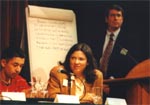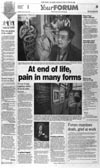Winter 2000
Rethinking the Old. Trying Something New.
By Tom Still
Associate Editor
Wisconsin State Journal
MADISON – “We the People/Wisconsin” (WTP) isn’t the nation’s longest-running civic journalism project for nothing. We have continually had to reinvent how we connect and engage with citizens.
And last year, we took our biggest step yet away from our tried-and-true reliance on town hall meetings and live broadcasts. Instead, we gathered citizen input through polls, focus groups, a day-long conference, and e-mail questions and feedback. In the process, we got better reporting and delivered more useful information to our readers, viewers and listeners.

Citizens met in a statewide conference rather than a town hall meeting to discuss health issues.
WTP was born in late 1991 as an election project of the Wisconsin State Journal and Wisconsin Public Television, with an emphasis on quarterly town hall meetings, televised live, to let citizens question candidates for public office. Before long, that basic format was expanded to include non-election topics, ranging from town halls on land use to juvenile crime.
Our partnership also expanded to include Wisconsin Public Radio and WISC-TV, Madison’s CBS affiliate and market leader. As we learned more and continued to experiment, the look and feel of our broadcasts changed. We went from the immediacy, unpredictability and unevenness of a live broadcast to a more polished presentation of the issues that included citizens’ voices. We also changed our strategy of involving citizens, not just people who wanted to play citizens on television.
Our newspaper and radio coverage has traditionally been focused around a live telecast, which was a one-hour town hall that included citizens recruited from earlier, non-broadcast town halls across Wisconsin. In effect, we planned and coordinated weeks, if not months, of coverage around a few hours of citizen deliberation.
Did it work? Sure, many of our broadcasts changed the course of public affairs in Wisconsin. (Citizen involvement at town halls has prompted sweeping property tax reforms and efforts to better manage land.)
Some of our broadcasts were ratings leaders – even in prime time. Independent research showed that WTP was recognized by four out of 10 people statewide, and our name became something of a household word among observers of citizen engagement in public affairs. People would ask, for instance, if we could “We the People” a particular topic – in effect, turning our noun into their verb.
Meanwhile, the circulation of the State Journal grew steadily – from 83,195 daily and 156,675 Sundays in January 1992 to 94,242 daily and 163,372 Sundays in November 1999. That growth was due to many factors, of course, but we believe our commitment to civic journalism played a major role.
We began to change our approach in 1998, a major election year for Wisconsin – and the state’s sesquicentennial.
It wasn’t that we thought anything was broken. We simply wanted to seize on the opportunity presented by a year-long event: What are the themes that held Wisconsin together 150 years ago and still define us today?
Using the “then-and-now” atmosphere of the sesquicentennial, we built our election coverage around four recurring themes – family, race, using the land and working – that resonated with citizens and that could be explored more deeply in the State Journal’s new “Your Forum” section.

The “Your Forum” section was launched in February 1998, replacing a traditional Sunday perspective section with an interactive, citizen-based front that has become one of the most widely read Sunday sections, according to our internal research.
The sesquicentennial coverage resulted in a Citizens Charter of concerns that helped anchor our election coverage later in the year. Still, our coverage was built around live broadcasts of town hall meetings.
As the year closed, we recognized that our break from episodic civic journalism – examining three or four unrelated topics in a year – had enhanced our ability to produce daily rather than project civic journalism.
How? By building on themes identified through WTP town halls, we were able to pursue those stories further, often using “Your Forum” to explore angles suggested by citizens but not fully developed in the town hall discussions.
In 1999, the evolution continued as we planned our “Growing Up … Growing Older” project. That effort is now changing how our media partners cover health.
Notice that’s “health” and not “health care.” That reflects our feeling – informed by conversations with citizens and experts and reinforced by polling data – that news coverage too often focuses on the politics and economics of health care without tapping into people’s core health concerns.
We liked that the sesquicentennial coverage was structured around one theme, which tied things together throughout the year and gave us continuity. People seemed to like it, too.
Now, we thought, instead of grazing the top of four different issues, why not focus on just one? It wasn’t borne of a dissatisfaction of what we were doing, because clearly a lot of what we did worked. But could we do it better?
It also tested the newsroom. We asked key editors to nominate the topic they would like to see addressed. We pulled in as many people as possible and created an expectation that they would do stories.
For the very first time we were able to get some reporters and editors to come to our early focus groups. We had buy-in. They were looking for fresh perspectives: What do people say that we’re missing?
That is a subtle but significant difference in our newsroom: There is an acknowledgement now that you must listen to hear what you are missing. In some newsrooms, you don’t even get to Square One on that.
In “Growing Up…,” we moved away from our traditional live broadcast to a documentary-style television hour on Wisconsin Public Television that focused on the health needs of children. Each partner approached the topic from a different perspective: The State Journal concentrated on brain development in young children, for example, while WISC-TV focused on child abuse in a nightly news series. Cross promotion in print and on air synchronized our efforts.
All of those topics and more were discussed in a day-long statewide conference, Nov. 8 in Madison, that attracted two nationally known speakers and 150 citizens, health professionals and advocates. The conference began with a discussion by randomly selected citizens who talked about their concepts of what makes for a healthy child – including some surprising observations about the responsibilities of families and neighbors to help young people. The conference ended with agreement on a handful of conclusions that were reshaped into poll questions.
Ninety minutes after the conference adjourned, we were in the field with a 400-person survey to test some of the ideas generated at the conference, such as targeting the state’s tobacco money for various health programs.
Three days later, we did a story on the poll. And the number-one choice for tobacco spending was child abuse, which was one of those sleeper topics. People don’t run around talking about child abuse.
This year, WTP will continue its “Growing Up…Growing Older” series with two more statewide conferences (Feb. 21 and May 8) focusing on the middle years and the elderly. Although it’s still in the planning stages, our journalism will probably focus on helping citizens learn more about alternative medicine – what’s bunk and what’s helpful – as well as “end-of-life” decisions that are inevitable but too often ignored. We’ll publish a resource guide for citizens and make sure policy-makers know how Wisconsin citizens feel about “health” as they consider new “health care” policies.
Live broadcasts? We’ll get back to those, probably as a part of our fall election coverage. For now, however, “We the People/Wisconsin” is following a different and exciting path.
_____________________________
Still is co-founder of “We the People/Wisconsin,” the nation’s oldest, continuously operated civic journalism project.
